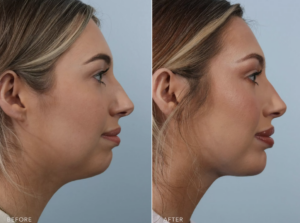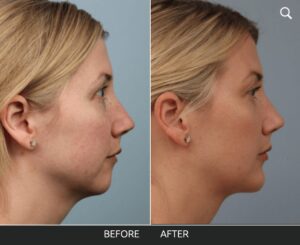Chin augmentation is a minimally invasive surgery to add prominence to the chin and achieve better harmony of the facial features by inserting a facial implant into the chin area.
This procedure may be performed alone or in conjunction with other procedures such as rhinoplasty, cheek augmentation or a facelift.
Chin augmentation isn’t the only way to add definition to your chin and jawline. Chin filler is a nonsurgical procedure, and could be an option for patients who do not wish to have surgery.
There are a few myths we’ve heard about chin implants throughout the years. Read on to learn more about the surgery and how each myth is disproven.

Results of a chin augmentation surgery done at The Williams Center
1. Chin Augmentation is a High-Risk Procedure
Chin augmentation or chin implantation is a minimally invasive surgical procedure and by no means is considered high-risk.
It can add prominence to the chin to help achieve better harmony of the facial features.
The procedure is quick, taking less than one hour to perform, and involves the insertion of a facial implant into the chin area.
This is a relatively safe procedure with low complication rates — especially if the procedure is done by an experienced facial plastic surgeon.
As with any operation, there are always risks of infection, bleeding, or poor healing — however, these complications are rare in chin implant surgeries at The Williams Center for Facial Surgery.
If you are interested in seeing how the procedure is done, you can view surgical footage of a chin augmentation using a Gore-Tex implant that was performed at The Williams Center.
2. Everyone Will Notice That I Had a Chin Augmentation
In the hands of an experienced facial plastic surgeon, this is simply not true.
Prior to going to the operating room, our doctors and staff sit down with patients to discuss goals and expectations.
Our main goal is to give patients a natural look that only enhances their existing features.
We use imaging software to give patients a preview of their results so that we are all in agreement on the aesthetic result we are trying to achieve.
Regarding the procedure itself, many people ask, “But won’t I have a scar?”
It is true that a small incision is made underneath the chin in order to insert the implant. This incision, however, is inconspicuous and hard to find once it has healed.
And the implants themselves are soft and feel the same as a normal chin. These implants are typically tapered to mimic the natural shape of a chin.
Some of our happiest patients are our postoperative chin augmentation patients because we can create a dramatic — but natural — result with such a simple procedure.
Below is an example of a 33-year-old patient that underwent chin implant surgery at The Williams Center.
We encourage you to visit the chin augmentation before-and-after image gallery for even more real results.
3. You Can’t Receive a Chin Implant at the Same Time as Other Procedures
It is often recommended to receive a chin implant procedure in combination with other facial procedures.
Many patients who go forward with a rhinoplasty or facelift also desire a chin augmentation.
For example, when our facial plastic surgeons assess a patient’s profile before a facelift, one of our biggest goals is to create an aesthetically appealing cervicomental angle or the angle created between the neck and the chin.
If patients have a small or receding chin, a chin implant complements the facelift and can really improve the results.
Similar to a facelift, in rhinoplasty, the entire face — not just the nose — is taken into account when deciding what changes to make.
If the patient has a receding chin, augmentation with an implant can enhance the rhinoplasty result and promote harmony between the facial features.
Combination procedures such as these are commonly performed, and there are no issues with doing them together. In fact, completing dual procedures at one time means just one instance of anesthesia.
However, if you decide not to go forward with a chin implant at the time of another surgery, you can absolutely come back at another time.
There will be no issue waiting for the chin implant procedure for a later time if that is what you prefer.
4. Chin Implants are Unsafe
The materials used to make chin implants are very safe and have been rigorously studied.
The most common material used is silicone — we prefer to use Gore-Tex-covered silicone implants, as these implants tend to not form a capsule, or scar tissue, around the implant. Plain silicone implants are more prone to capsule formation.
In addition, due to the unique properties of the Gore-Tex coating, it anchors more firmly to the surrounding tissue, resulting in a more natural feel.
Infections from these chin implants are uncommon and we rarely see them at our practice.
5. You Can’t Have a Chin Implant Removed
In experienced hands, the implant rarely must be removed or replaced.
However, if it does have to be removed, one of the advantages of using the Gore-Tex implant is that, as mentioned above, it anchors into surrounding tissue, but there is no capsule formation.
This means that it can be more easily removed than a plain silicone implant, if removal is necessary.
If you are considering whether or not a chin implant is right for you, we would be happy to see you at The Williams Center to discuss your goals and whether or not surgery would be a good option for you.
If you have any questions regarding this procedure, or would like to initiate a consultation, please give us a call at (518) 1-800-742-2797 or schedule your consultation today.

